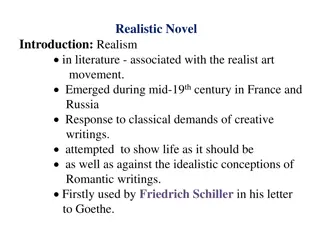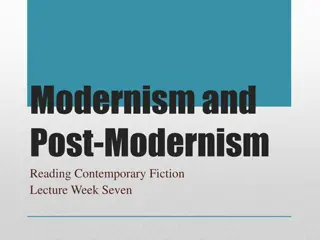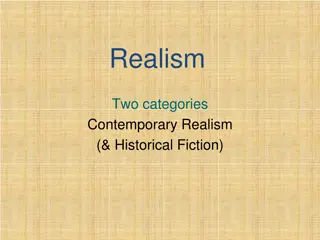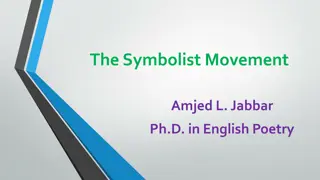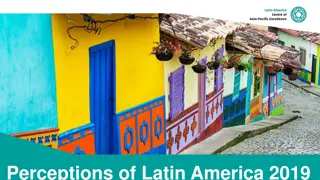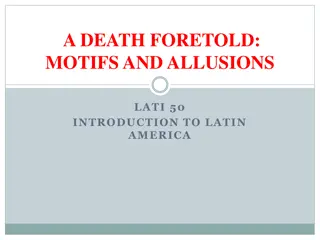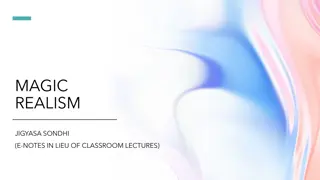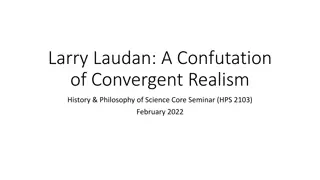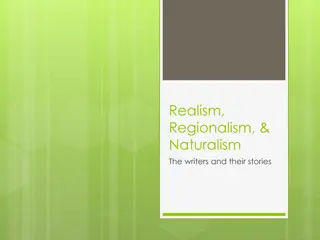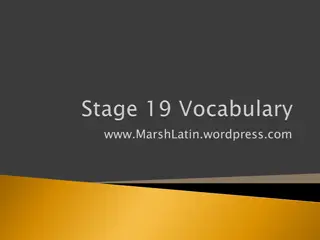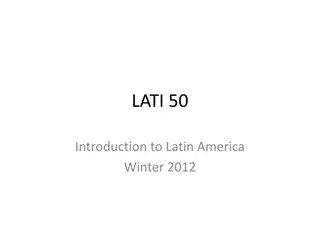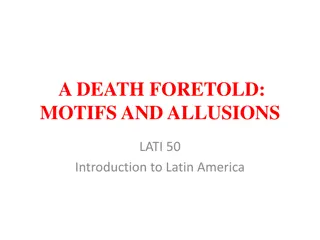Exploring Latin American Literature through History and Magic Realism
Latin American Literature encompasses a rich tapestry of national literatures from South and Central America, Mexico, Cuba, Puerto Rico, and parts of the West Indies. With roots in European traditions and indigenous cultures, this literary landscape is intricately tied to the continent's history and politics. From colonial chronicles to the emergence of foundational fictions and the transformative power of Magic Realism, this literature reflects a journey of identity, resilience, and reclamation.
Download Presentation

Please find below an Image/Link to download the presentation.
The content on the website is provided AS IS for your information and personal use only. It may not be sold, licensed, or shared on other websites without obtaining consent from the author. Download presentation by click this link. If you encounter any issues during the download, it is possible that the publisher has removed the file from their server.
E N D
Presentation Transcript
Latin American Literature Jigyasa Sondhi (E-NOTES IN LIEU OF CLASSROOM LECTURES)
INTRODUCTION Encompasses national literatures of South and Central America, Mexico, Cuba, Puerto Rico, parts of West Indies Roots lie in European language and literary traditions + images and themes drawn from physical landscape + indigenous cultures of South Ame. continent
Intrinsically connected to politics of Europe since Columbus sea voyage to America in 1492 Spanish, Portuguese, other European conquerors estd a no. of settlements in South Ame. Pre-Columbian cultures primarily oral, though Aztecs and Mayans for instance, produced elaborate codices. Oral accounts of mythological and religious beliefs were also sometimes recorded after arrival of European colonisers, as was case with Popol Vuh. Tradition of oral narrative survives to this day eg Quechua speaking pop. of Peru, Quich of Guatemala.
From the very moment of Europe s discovery of the continent, early explorers and conquistadores produced written accounts and cr nicas of their experience eg Columbus letters, Bernal Diaz del Castillo s description of conquest of Mexico. During colonial period, written culture often in hands of the Church, within which context Sor Juana In s de la Cruz wrote memorable poetry and philosophical essays. Towards end of 19th cen., distinctive Criollo lit tradition emerged, including first novels such as Lizardi sEl Periquillo Sarniento (1816).
19th cen. period of foundationalfictions , novels in romantic + naturalistic traditions that attempted to establish sense of national identity, often focussed on indigenous question or dichotomy of civilization or barbarism . Cuban Revo. 1959 marked sense of identity for entire South Ame. Continent political space, literature, storehouse of new & old ideals. This literature now housed newly-discovered confidence, commitment, sense of power, desire to re-invent strong family & community traditions that had always been central to oral literature of earlier periods.
Magic Realism (detailed ppt to follow) Mexican Revo. inspired novels such as Mariano Azuela sLos de Abajo, a committed work of social realism (revo. & aftermath would continue to be a pt of reference for Mexican Lit. for many decades). 1940s Alejo Carpentier (Explosion in a Cathedral) coined term, lo real maravilloso or marvellousreal . Later became MR or intro of supernatural, uncanny elements into otherwise realistic narrative. Whole idea of solitude of Latin Ame best understood by concept of MR. Notion that Latin Ame. always described in peculiar, mysterious and fantastic terms. Always seen in opposition to European mind and hence appears to be quite incomprehensible and inaccessible.
Modernismo (modernism) Turn of 20th cen. mod. emerged. Poetic mvmt whose founding text was Nicaraguan poet Rub n Dario sAzul. First Latin Ame. lit mvmt to influence lit culture outside region + first truly Latin Ame. Lit. in that national differences were no longer so much an issue. Eg- Jos Marti though Cuban patriot also lived in Mexico & USA, wrote for journals in Argentina etc. Though mod. itself often seen as aestheticist, anti-political, some poets & essayists (Marti, Peruvians Manuel Gonz lez Prada, Jos Carlos Mari tegui), introduced compelling critiques of contemporary social order and particularly plight of Latin Ame. s indigenous peoples. (cont. )
Modernismo cont. Indigenismo early 20th cen. mvmt dedicated to representing indigenous culture and injustices that such communities were undergoing, ad for instance, with the Peruvian Jos Maria Arguedas and Mexican Rosario Castellanos.
The Literary Boom. What really put Latin Ame. lit on the map was literary boom of 1960s 70s, distinguished by daring experimental novels eg Julio Cortazar sRayuela (1963), frequently published in Spain, quickly translated into English Defining novel One Hundred Years of Solitude (GGM). Led to association of Latin Ame. lit with MR. 1960-67 Major works of Boom were published. Many novels somewhat rebellious from general viewpoint of Latin Ame. culture. Authors crossed traditional boundaries, experimented with lang., often mixed different styles of writing in other works.
Aregntine Jorge Luis Borges (Hopscotch) invented what was almost a new genre, philosophical short story; went on to become one of the most influential of all Latin Ame. writers. 20th cen. poetry often expressed political commitment, particularly given on model provided by Chilean Nobel Laureate Pablo Neruda, followed by Nicaraguan Ernesto Cardenal, Salvadorean Roque Dalton. Though Boom occurred while Latin Ame. was having commercial success, works of this period tended to movie away from positives of modernisation that was underway. Instead, lit works focussed on problems, injustices people were suffering across Latin Ame.
Changes that took place due to Spanish-Ame. writers, their influence on other writers etc. Structures of lit works were also changing. Inspired by North Ame. & European authors (William Faulkner, James Joyce, Virginia Woolf et al), Boom novels were often non-linear, disregarding conventional rules, introducing techniques such as internal monologue. Latin Ame. authors were also inspired by each other s works. Many of the authors knew one another & influenced each other s styles.
Post-Boom: Lit became characterised by a tendency towards irony, use of pop genres ( eg - Manuel Puig) Some writers felt success of Boom to be a burden, spiritedly denounced caricature that reduces Latin Ame. lit to MR. There came about a change Alberto Fuguet came up with McOndo antidote to Macondo-ism that demanded of all aspiring writers that they set their tales in steamy tropical jungles in which the fantastic and the real happily co-existed.
Dirty Wars Political turmoil in Latin Ame. Countries such as Cuba at this time Influenced lit Boom as well Some works anticipated an end to prosperity that was occurring, even predicted old problems would resurface in the near future Their works foreshadowed the events to come in the future of Latin Ame., with the 1970s and 80s dictatorships, economic turmoil and dirty wars
Prominent authors Paulo Coelho Isabel Allende Luisa Valenzuela Ricardo Piglia Juan Carlos Onetti Juan Jos Arreola Julio Cort zar Carlos Fuentes
Often chaotic political atmosphere of contemporary Latin Ame. continues to generate writing that is both artistic and activist in nature. Recent decades have seen an increase in works devoted to the specific struggles of blacks, indigenous peoples and othe rminorities. With exception of Brazilian lit, which is written primarily in Portuguese, nearly all Latin Ame. lit is in Spanish, is often designated by critics as Spanish-American or Hispanic-American lit
Latin Ame. writers are radical writers, narrators dedicated to a cause Not enough for them to create, versify Many of them have of course participated in hardcore political mvmtsof their times, represented their countries in foreign official positions That the Nobel Prize in Literature has gone several times to their land indicates more than their creativity








